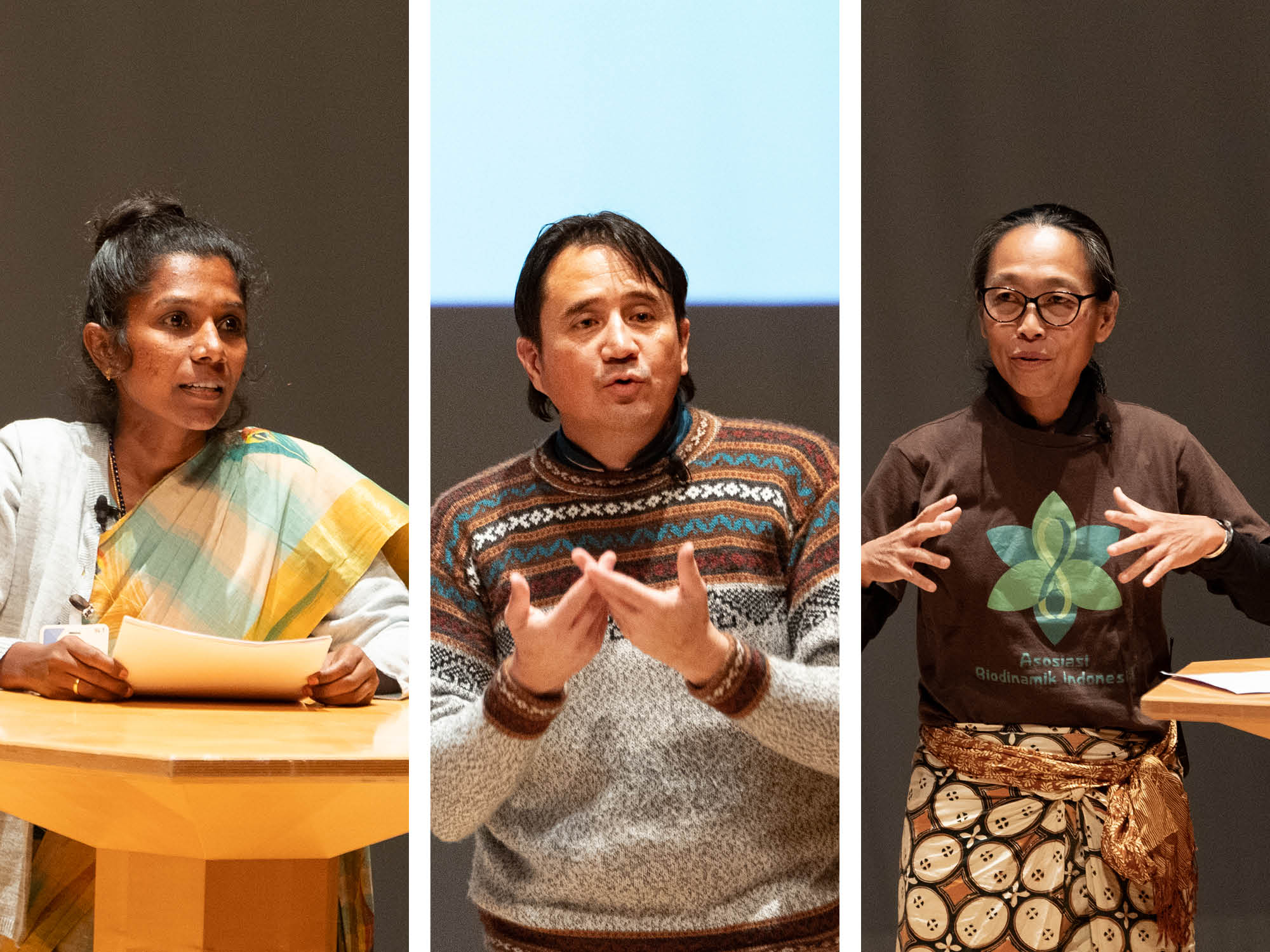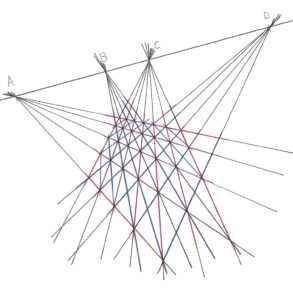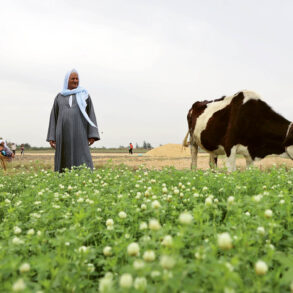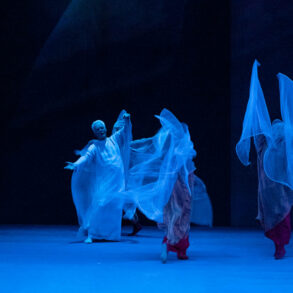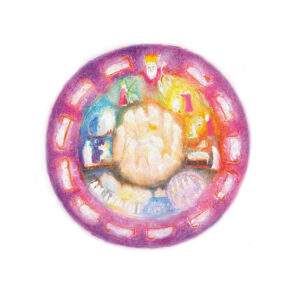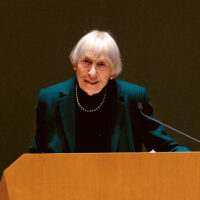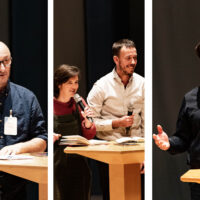There are still communities around the world that live with the Earth as a living being. People still ask permission to go into the field. They still speak to the four elements. They are still thankful. They still pray for the Earth. A conversation with representatives of three of these communities, moderated by Eduardo Rincón.
Eduardo Rincón Thank you so much for being here. Please tell us a little about yourself.
Anthoniselvi Savarimuthu I’m a proud biodynamic farmer and educator from Tamil Nadu, India, a land with a history as rich as its soil and a culture as ancient as its mountains. When we speak of Indian indigenous wisdom, most people think of the Vedas. While these texts hold great value, I would like to draw your attention to the Tamil culture from over 3000 years ago that left behind profound agricultural and ecological practices that still resonate today. Tamil traditions, as recorded in the Sangam literature, reveal a deep understanding of the interconnectedness between humans, nature, and the cosmos.
The ancient Tamil Community categorized their land into five tinai, each associated with a particular landscape—mountain, forest, farmland, coast, desert—a living ecosystem with integrated flora, fauna, and human activities. The ancient classification teaches us to respect ecosystem diversity and adapt agricultural practices to the specific conditions of each region. I am not just the daughter of a peasant farmer from rural India but also of the beautiful mountains of my region. Tamils believe in the sanctity of all life: Sangam poets wrote about hunters stopping their chariots to avoid disturbing nesting birds, and the great Tamil philosopher Thiruvalluvar emphasized the equality of all living beings, no matter how tiny. Steiner’s seven life processes also have remarkable parallels in ancient Tamil agricultural wisdom. These timeless principles showcase a profound harmony between humanity and nature.
“All places are our homes. All people are our kin. Neither good nor evil comes from others.”—Kaniyan Poongundran
Diego Porras, I bring you voices from the Americas, that continent that, even with such complex political situations, is a symbol of unity from the south to the north. I am from Colombia and am now a sustainable agroecological specialty coffee producer in Mexico. I travel to other indigenous communities and learn from them, and work on projects that connect the South and North to support indigenous communities to market their coffee internationally.
I must tell you, my acceptance and study of biodynamics was because the first time I approached a ceremony of making biodynamic preparations, the words came back to me of Taita Manuel, an indigenous Inganos from southern Colombia who taught me how the plants themselves taught him how to heal people in the community. So when I started doing biodynamics, everything made sense to me.
Everywhere, from south to north, we find these concepts and traditions. In the southern Andean mountains of Bolivia and Equador, the Quechua and Aymara have this beautiful concept of Pachamama, Earth Mother. A bit further north, in southwest Colombia, the Misak and the Nasa have concepts of working together for the good of the community. In northern Colombia, the Arhuacos have a concept of interdependence between humans and the natural environment. Further north, in Guatemala, the Maya Kʼicheʼ have a calendar that gives a unique energy to every day, bringing different moods for people to do different work. Also, in this Mesoamerican region, there is this beautiful law of In Lak’ech Ala K’in, which means “You are me, and I am you.” We say: “I am another you, and you are another me.” The Tzotzil in southern Mexico have a word that connects the earth and the sky together. In those regions, we have the concept of minga: working together for the common good. There is a mountain range in central eastern Mexico, Sierra de Zongolica, where they have a very special ceremony called Xochitlali to offer flowers and fruits every time they start planting or harvesting.
In all these regions, there is a beautiful concept that in the Andes is called el buen vivir. Something like “the good living,” but we cannot really understand it with the Western idea of quality of life. So, I’ve talked about 9 or 10 ethnic groups, but more than 100 languages and ethnic groups are in that region! The wisdom of indigenous people connects us to the past, the present, and the future. The message that I want to bring from the Americas and from the wisdom of the indigenous people in the South is a message full of hope—it’s full of love, and it’s very optimistic. We are living in very difficult times, but we know that this wisdom is always there. It’s not something from the past—it’s happening right now, out there.
Etha Widiyanto The story that I bring is from the island of Bali, where I lived most of my life. It was not a coincidence that Bali is often called the island of the gods because this kind of puja [she shows a picture of a colorful outdoor religious ceremony] is one that you see in your everyday life. This spirituality, culture, and life is practiced all through the island since ancestral times. Today, some of these practices may be slightly changed, maybe some of the rules bent a little, some of the offerings modified for practicality. But one that has not changed and we still practice in pretty much the same way, full of faith and without question, is the Bali Wariga, the way to perfection. It is an ancient knowledge. It basically teaches the ancient Balinese calendar.
Hardly any events in Balinese life take place without first picking an auspicious day for it. That includes weddings, the best day to harvest bamboo, or sow rice, or plant fruit or breed animals, or start a business, or build a house, or even a good day to pay your debt. I have this Balinese wall calendar used all across the islands. And I guarantee on your next visit to Bali, you walk into any house and you will find it. But only some people learn to read the calendar deeply. We make an appointment and talk to them about what we intend to do, and they pick a day for us. [She shows a richly detailed calendar.] And this is our biodynamic calendar from our association in Bali. We do not want to eliminate anything we learn about this biodynamic farming method—it’s really close to what we have. So the only way is to put them together. You farmers can decide: if you can wait 1 or 2 days for the right moment, then you wait. Otherwise you make your own decision and take your own responsibility.
What I bring is from one island, Bali. But in the Indonesian archipelago, we have 13,000 islands! Many practice indigenous and tribal farming and have a moon and sun calendar that they use every day. So, our intention is to rediscover our local wisdoms throughout the archipelago through different sets of eyes and minds, different perspectives, and different ways of learning.
ER What is still alive in your communities from ancient wisdom that we in other parts of the world can learn from?
EW In Bali, when we start everything, we always ask permission. Not too big—little offerings. Sometimes, in the modern day, we forget. We think: it’s our land, we just do it. But it was actually our ancestral land. The universe owns all this. We borrow it. So, permission. Second, when we get the crops at the end, we are grateful. We offer our thanks. And with this, we maintain a balance in the middle: not too much, just enough for us to eat, not to make the most money.
AS I come from a community in India where 150 farmers cultivate their land in their own way, on a small scale. We live as a community, viewing the Earth and the world as our shared foundation, almost like a religion. That is why I believe in farming together, trusting, and working in harmony with the Earth.
DP I think that concept which we found in different regions, for example, minga in Colombia, ayni in Bolivia, and techio in Mexico: getting together to work for something that benefits not the individual or one family or group, but that benefits the community.
ER Yes, these groups are very, very good at working together for the benefit of their community and the Earth. Diego, you work with a particular crop, coffee. Can you touch on the reality of the indigenous communities in conjunction with the economy?
DP It is a big challenge to connect small coffee producers with the international coffee market. For very small pieces of land in very remote regions, the only way to face an international market is to get together. The concept of a social economy in the form of a cooperative came from these communities that brought the first Fairtrade initiative: a community of consumers in Europe, producers in Mexico, and indigenous people in Oaxaca, Mexico. We work with people in the north who have a lot of connections, knowledge, and power in international markets, and we bring that into respectful conversation with indigenous groups in the south. We make relationships that are respectful and long-term.
ER Etha, please tell us a little bit more about the archipelago: how is it working with the calendar?
EW The Balinese calendar has the same root as the Javanese calendar, but they don’t use it as much as we do because, maybe, among all the islands, Bali practices spirituality the deepest. Other islands like Java are more modern—only the people in the villages do it. But throughout Indonesia, from Sumatra to Java, all the way east, is rice farming, and they all wait for the moon at the right time to start sowing or working on the land. Our Balinese calendar, which I presented, has the movement of the sun, moon, and five planets visible to the naked eye. Only a few people in the past were educated to read it, and most cannot explain it. So it’s just: my father or grandfather did this, and I will do this. We get a lot of stories: I forgot to do something on the calendar, and my rice got destroyed by flying pests. This is further research for us.
ER Anthoniselvi, how is working with biodynamics for you, in relationship to the ancient wisdom?
AS I’m learning that biodynamics is not a separate form of farming—it is deeply rooted in our indigenous practices. By integrating it with my ancestral traditions, it adds greater meaning to our lives and the food we grow. We even experienced a drought lasting 5 to 8 years, yet our soils remained resilient, retaining the little rainwater we received. This was only possible because of biodynamic farming, which enriched the quality of our soil.
ER What are the challenges that your communities are facing in terms of working for the future?
AS However, people today are not ready for community-based farming. Each farmer has their own “I.” They are caught up in their own individual approach, isolated by modern agricultural practices, whether it’s dependence on machinery, market-driven farming, or the belief that using a particular seed variety will guarantee higher yields or pest resistance. But they often overlook the most crucial factor, the unique characteristics of their own land and soil.
EW Our farms are small. In our biodynamic association in Bali, 12 hectares is the biggest. Who buys organic food? Mostly expats living in Bali, not our own people. This is sad for our community. A Demeter-certified farm is far from our reach, for now. So our goal is to make everybody realize: we grow this food for us first, for our family first, and then we grow it better, and the community that supported us can buy our food. The second challenge is our festivals, for example, Tumpek Wariga, the day where we make offerings to the plants, trees, and land. We would like to keep this tradition but explain it to our newer generation. They cannot take the story like it is—they don’t buy it. So we do this festival our way, every 210 days, to introduce this old story in a different way.
DP Ask our small farmers, 15 or 20 years ago, and they knew very well the cycles of the crops. Weather and nature gave us signals; activities on the farm were very clear. But now, this is very different. We have rainy seasons with more water and at different times of the year. Dry seasons are longer, with more heat. The other challenge is that communities have very low incomes. The competition from products from outside markets is very big. So it’s hard for producers and families to decide what to get on the market. There is pressure to buy products from cities and big distribution markets. In Central America and southern Mexico, there is also a lot of migration north and to cities. Farmers are struggling to get labor.
ER Yet, there is a lot of strength in your community as hope for the future, and you are all bringing this hope to us. These communities have been resilient for so many thousands of years, seeing all kinds of challenges and still holding for the future. Do you feel happy? Enthusiastic? Hopeful?
ALL Yes, indeed!
These are edited excerpts from the panel conversation held at the Agriculture Conference in Dornach, 2025. The entire conversation will be available on Goetheanum TV.
More Agriculture Section at the Goetheanum
Image (from left to right) Anthoniselvi Savarimuthu, Diego Porras, Etha Widiyanto. Photos: Xue Li

